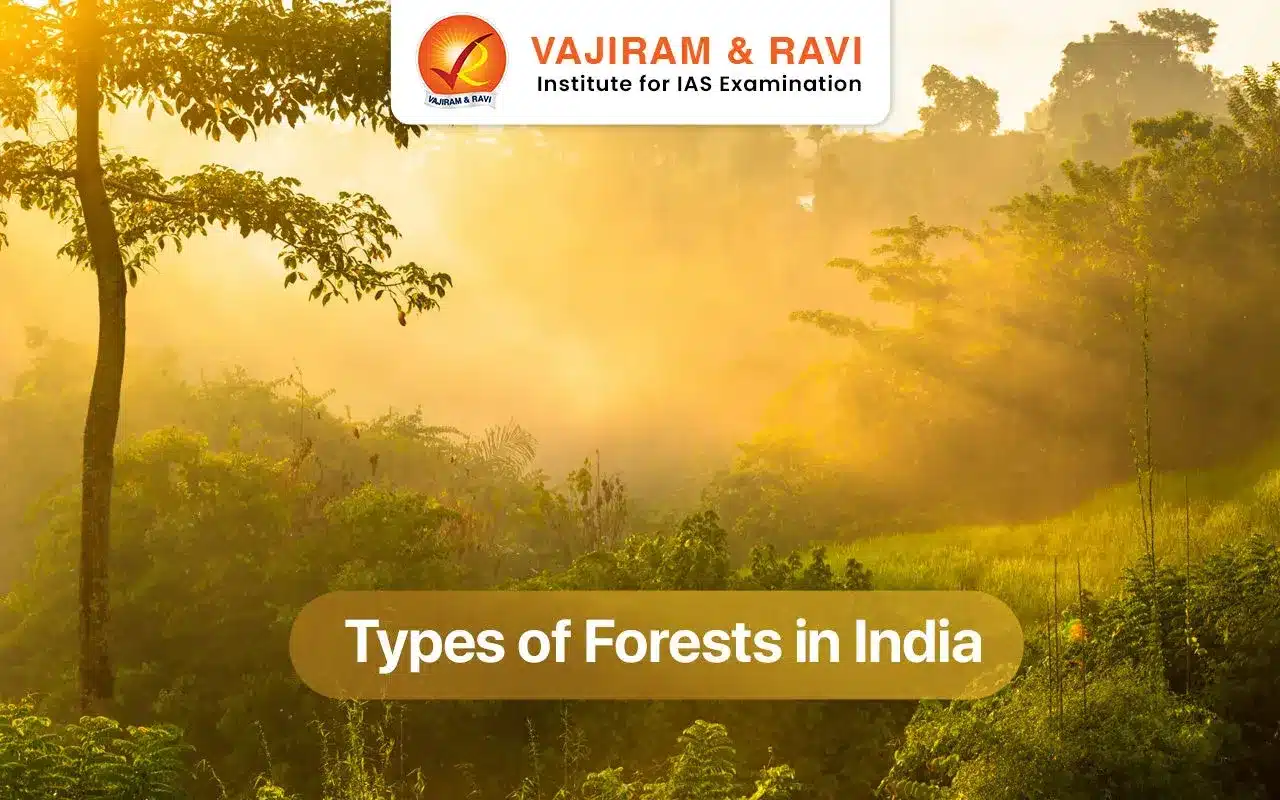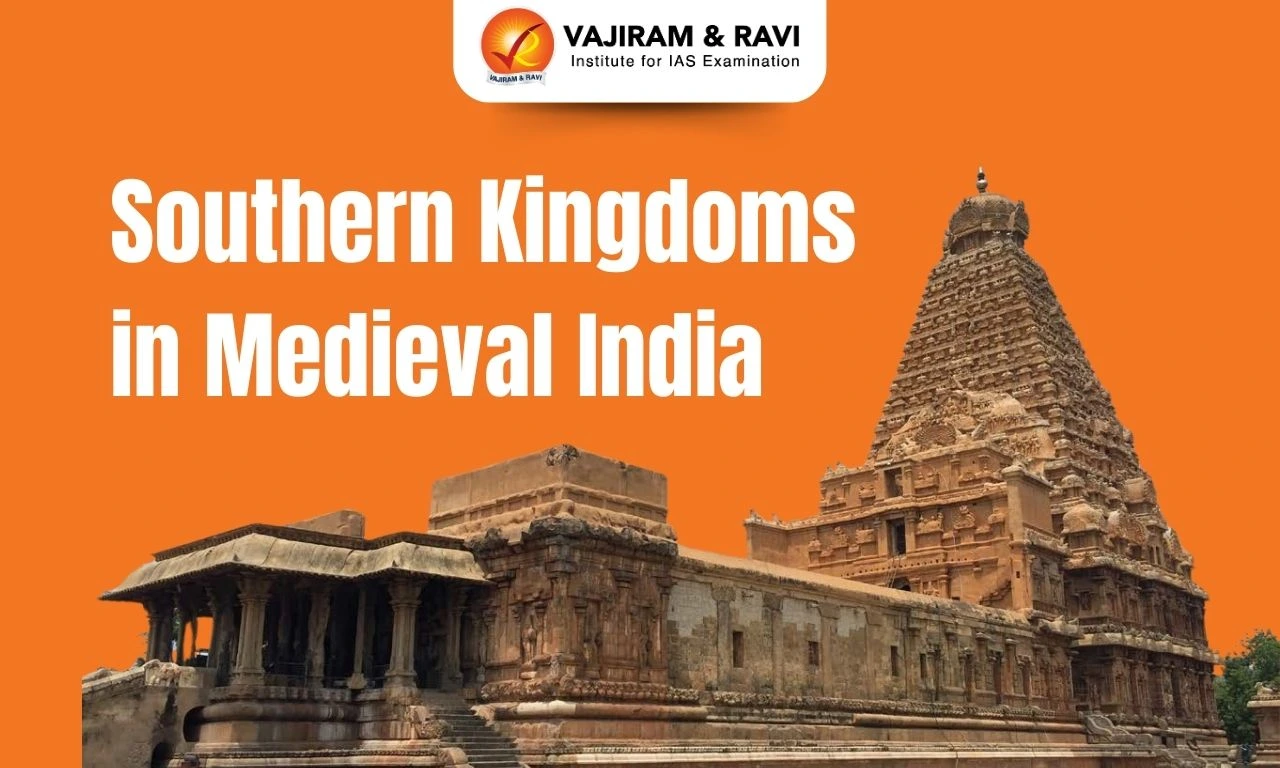India has a wide variety of forests, from the rainforests of Kerala in the south to the alpine meadows of Ladakh in the north, from the deserts of Rajasthan in the west to the evergreen forests of the northeast. These variations are determined by factors such as climate, soil type, topography, and elevation. Additionally, forests can be categorised based on their characteristics, composition, prevailing climate, and interactions with the surrounding environment.
Accordingly, Indian forest types include moist tropical, dry tropical, montane sub-tropical, montane temperate, and alpine forests.
Classification of Forest
Classification of forests is primarily based on spatial and annual rainfall. However, Champion & Seth's system of classification provides an elaborate description of forest types in India in six major groups which are further divided into 16 type groups and are subdivided into 200 types including subtypes and variations of forests.
- The 'forest type' is defined asa unit of vegetation with specific physiognomy and structure sufficiently pronounced to permit its differentiation from other such units.
- The determining factors of the forest types are climate, soil, vegetation, and past treatment (including biotic interference).
- Major classification: Moist tropical, dry tropical, montane sub-tropical, montane temperate, alpine forests.
- Other classification: For other purposes, forest resources in India are classified as constitution-based, administration-based, ownership-based, composition-based, and exploitation-based classification.
Moist Tropical Forests
Moist tropical forests, also known as tropical rainforests, are dense, lush forests found in equatorial regions characterised by high temperatures, abundant rainfall, and extraordinary biodiversity. They can be subcategorized as follows:
- Tropical Wet Evergreen Forests: These are characterised by dense vegetation that remains green throughout the year, boasting a rich diversity of plant and animal species.
- Climatic conditions: It requires an average annual rainfall of >250 cm and 25°-27°C temperature.
- Distribution: Andaman and Nicobar (A&N) Islands, Hills of the North-Eastern region, and the western slopes of the Western Ghats (Kerala & Karnataka).
- Flora: They are known for fine-grained, durable, and robust timber
- For example Mahogany, Epiphytes, Mesua, White Cedar, Jamun, Canes, and Bamboo.
- Tropical Semi-Evergreen Forests: These are transitional ecosystems, featuring a mix of evergreen and deciduous tree species. They thrive in regions with moderate rainfall and exhibit a seasonal variation in leaf shedding.
- Climatic Conditions: It requires an average annual rainfall of 200-250 cm and 24°-27°C temperature.
- Distribution: Lower slopes of the Eastern Himalayas, Western coast, Assam, Odisha.
- Flora: Laurel, rosewood, Mesua, thorny bamboo, white cedar, Indian chestnut, Champa, mango, etc.
- Tropical Moist Deciduous Forests These trees shed their leaves during a distinct dry season, thriving in regions with pronounced wet and dry periods.
- Climatic Conditions: It requires an average annual rainfall of 100-200 cm and about 27°C temperature.
- Distribution: Manipur, Mizoram, Madhya Pradesh, Chhattisgarh, Most of Odisha, Chota Nagpur Plateau, and A&N Islands.
- Flora: Teak, Sal, Laurel, Rosewood, Amla, Jamun, Bamboo.
- Littoral and Swamp Forests: They can survive and grow both in brackish and fresh water. These ecosystems are found along coastlines and in swampy areas, featuring trees adapted to waterlogged conditions. They provide critical habitat for various aquatic and semi-aquatic species and play a vital role in coastal protection and water filtration
- Climatic Conditions: Trees are adaptable to both fresh and brackish water.
- Distribution: The most famous and the densest is the Sunderbans in the Ganga delta.
- Flora: Sundri, Screw pines, Agar, Rhizophora, Canes, and Palms
Dry Tropical Forests:
Dry tropical forests are biomes characterised by low rainfall levels and seasonal droughts, supporting vegetation adapted to arid and semi-arid conditions.
- Tropical Dry Evergreen Forests: They are characterised by evergreen trees adapted to regions with distinct dry seasons. Despite limited rainfall, these forests retain their foliage year-round, supporting a unique assemblage of plant and animal life.
- Climatic Conditions:
- Rainfall: 100 cm.
- Temperature: Approximately 28°C.
- Distribution: Along the coastal area of Tamil Nadu.
- Flora: Jamun, tamarind, neem
- Climatic Conditions:
- Tropical Dry Deciduous Forests: These are regions where trees shed their leaves during dry seasons, common in areas with distinct wet and dry periods, hosting diverse plant and animal life.
- Climatic Conditions:
- Mean Annual rainfall: 100-150 cm.
- Distribution: Foothill of the Himalayas to Kanyakumari except in Rajasthan, West Bengal, and Western Ghats.
- Flora: Teak, axlewood, bamboo, laurel, rosewood, red sanders, satinwood, and other species.
- Climatic Conditions:
- Tropical Thorn Forests: They are characterised by sparse, drought-resistant vegetation.
- Climatic Conditions:
- Rainfall: <75 cm
- Temperature: 25°-30°C.
- Distribution: Rajasthan, western Haryana, Punjab, Kachchh, and Saurashtra in the west, as well as the Western Ghats in Maharashtra, Karnataka, Telangana, Andhra Pradesh, and Tamil Nadu in the south.
- Flora: Neem, Babul, Cacti, etc.
- Climatic Conditions:
Montane Sub-Tropical Forests
They are forest ecosystems found at higher altitudes in subtropical regions, characterised by diverse flora and adapted to cooler temperatures.
- Sub-tropical Broad-leaved Hill Forests: They are situated at moderate elevations in subtropical regions, distinguished by a variety of broad-leaved tree species and high humidity levels.
- Climatic Conditions:
- Rainfall: 75 cm -125 cm
- Temperature: 18°- 21°C
- Distribution: Eastern Himalayas at altitudes varying from 1000 to 2000 m.
- Flora: Oak, chestnut, ash, sal, and pine trees.
- Climatic Conditions:
- Sub-tropical Moist Pine Forests: They constitute a diverse ecosystem with a unique mix of flora and fauna adapted to subtropical climates that thrive in regions with moderate winters and warm summers.
- Distribution: Western Himalayas (at elevations 1000 to 2000 m.)
- Flora: Chir is the most dominant tree forming pure stands. It supplies great wood for boxes, furniture, and structures. It is also used to produce resin and turpentine.
- Sub-tropical Dry Evergreen Forests: These forests have resilient ecosystems found in regions with limited rainfall, featuring evergreen trees adapted to drought conditions, often interspersed with shrubs and grasses, supporting diverse wildlife species adapted to arid environments.
- Climatic Conditions: Rainfall: 50-100 cm; the summers are hot and the winters are very cold.
- Distribution: Found in the Shiwaliks and the western Himalayas up to about 1000 m above sea level.
- Flora: Low scrub forest with small evergreen trees and shrubs. Olive, Acacia, and pistacia
Montane Temperate Forests
Montane temperate forests are evergreen or deciduous forests found at mid-elevations on mountainsides. They are characterized by cool temperatures, moderate to high rainfall, and coniferous or broadleaf trees.
- Montane Wet Temperate Forests: are biodiverse ecosystems found in mountainous regions, characterized by high rainfall, cooler temperatures, and lush vegetation, serving as critical habitats for diverse flora and fauna
- Climatic Conditions:
- Rainfall: 150 cm to 300 cm
- Temperature: 11°C to 14°C.
- Distribution: Higher hills of Kerala and Tamil Nadu, in the Eastern Himalayan region.
- Flora: Deodar, Indian chestnut, birch, Chilauni, plum, machilus, Cinnamomum, blue pine, magnolia, oak, hemlock, etc.
- Climatic Conditions:
- Himalayan Moist Temperate Forests: Rich ecosystems found in the Himalayan region, featuring diverse vegetation including broadleaf and coniferous trees, thriving in cool, moist conditions, crucial for biodiversity and watershed protection in the region.
- Climatic Conditions:
- Rainfall: 150 cm to 250 cm
- Distribution: Occurs in the temperate zone of the Himalayas. Cover the entire mountain range in Kashmir, Himachal Pradesh, Uttarakhand, Darjeeling, and Sikkim.
- Flora: Composed of coniferous species mainly Pines, cedars, silver firs, spruce, etc.
- Climatic Conditions:
- Himalayan Dry Temperate Forests: The ecosystems in the Himalayan region are characterized by sparse vegetation, dominated by drought-tolerant trees, adapted to the region's dry and cooler climate, crucial for soil stabilization and supporting unique wildlife species.
- Climatic Conditions: Rainfall: <100 cm (mostly in the form of snow)
- Distribution: Inner dry ranges of the Himalayas - Ladakh, Kinnaur, Garhwal, Lahaul, Chamba, and Sikkim.
- Flora: Coniferous forests with xerophytic shrubs Deodar, oak, ash, olive, etc are the main trees.
Alpine Forests:
Alpine forests are high-elevation woodlands with cold temperatures, short growing seasons, and hardy conifers.
- Sub-alpine Scrub
- Climatic Conditions: Occur throughout the Himalayas above 3000 m elevation up to the tree limit; Rainfall 83-600 mm.
- Distribution: Western Himalaya sub-alpine forests reported from Jammu and Kashmir, Himachal Pradesh, Uttrakhand, Arunachal Pradesh, Sikkim, and West Bengal.
- Flora: Abies densa and Betula utilis, and Rhododendron spp, Abies spectabilis, and Betula utilis
- Moist- Alpine Scrub
- Climatic Conditions: Moist Alpine Scrub occurs throughout the Himalayas, above timberline to 5,500m altitude.
- Distribution: Uttrakhand, in inner Himalaya, Arunachal Pradesh, Sikkim and West Bengal.
- Flora: composed entirely of species of Rhododendron with some birch (Betula) and other deciduous trees.
- Dry- Alpine Scrub
- Climatic Conditions:
- Rainfall < 370mm
- Distribution: Jammu and Kashmir, Himachal Pradesh, Uttrakhand, and Arunachal Pradesh.
- Flora: Juniperus wallichiana, Lonicera spp, Potentilla spp.,Honeysuckle & Juniper etc.
- Climatic Conditions:
Types of Forests in India UPSC PYQs
Question 1: Which one of the following regions of India has a combination of mangrove forest, evergreen forest, and deciduous forest: (UPSC Prelims 2015)
- North Coastal Andhra Pradesh
- South-West Bengal
- Southern Saurashtra
- Andaman and Nicobar Islands
Answer: (a)
Question 2: Consider the following States: (UPSC Prelims 2015)
- Arunachal Pradesh
- Himachal Pradesh
- Mizoram
Which of the statements given above is/are correct?
- 1 only
- 2 and 3 only
- 1 and 3 only
- 1, 2 and 3
Answer: (c)
Question 3: In India, in which one of the following types of forests is teak a dominant tree species? (UPSC Prelims 2015)
- Tropical moist deciduous forest
- Tropical rainforest
- Tropical thorn scrub forest
- Temperate forest with grasslands
Answer: (a)
Question 4: “Leaf litter decomposes faster than in any other biome and as a result, the soil surface is often almost bare. Apart from trees, the vegetation is largely composed of plant forms that reach up into the canopy vicariously, by climbing the trees or growing as epiphytes, rooted on the upper branches of trees.” This is the most likely description of (UPSC Prelims 2021)
(a) Coniferous forest
(b) Dry deciduous forest
(c) Mangrove forest
(d) Tropical rainforest
Answer: (d)
Last updated on December, 2025
→ Check out the latest UPSC Syllabus 2026 here.
→ Join Vajiram & Ravi’s Interview Guidance Programme for expert help to crack your final UPSC stage.
→ UPSC Mains Result 2025 is now out.
→ UPSC Notification 2026 is scheduled to be released on January 14, 2026.
→ UPSC Calendar 2026 is released on 15th May, 2025.
→ The UPSC Vacancy 2025 were released 1129, out of which 979 were for UPSC CSE and remaining 150 are for UPSC IFoS.
→ UPSC Prelims 2026 will be conducted on 24th May, 2026 & UPSC Mains 2026 will be conducted on 21st August 2026.
→ The UPSC Selection Process is of 3 stages-Prelims, Mains and Interview.
→ UPSC Result 2024 is released with latest UPSC Marksheet 2024. Check Now!
→ UPSC Prelims Result 2025 is out now for the CSE held on 25 May 2025.
→ UPSC Toppers List 2024 is released now. Shakti Dubey is UPSC AIR 1 2024 Topper.
→ UPSC Prelims Question Paper 2025 and Unofficial Prelims Answer Key 2025 are available now.
→ UPSC Mains Question Paper 2025 is out for Essay, GS 1, 2, 3 & GS 4.
→ UPSC Mains Indian Language Question Paper 2025 is now out.
→ UPSC Mains Optional Question Paper 2025 is now out.
→ Also check Best IAS Coaching in Delhi
Types of Forests in India FAQs
Q1. What are the different types of forests in India?+
Q2. Which forest type occupies the largest area in India?+
Q3. What are the proportions of various forest types in India?+

















